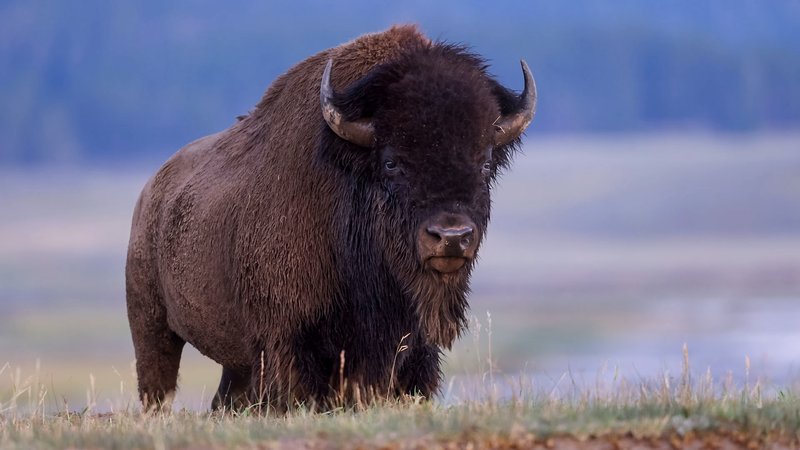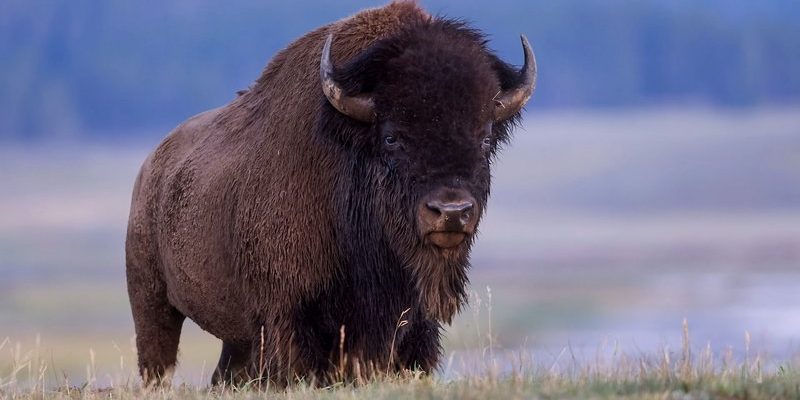
When thinking about bison, it’s easy to imagine them lumbering peacefully across a landscape, much like a gentle giant. But, just like any big creature, they have their limits. If you get too close or act in a way they perceive as threatening, they can become aggressive. Let’s take a deeper dive into understanding bison behavior, how they interact with humans, and why respecting their space is essential.
Understanding Bison Behavior
To grasp whether the American bison can be dangerous, it’s crucial to understand their behavior. Bison are typically calm animals, but they can be unpredictable. Imagine you’re at a park, and someone suddenly gets too close to your personal space. You might react defensively, right? Bison, being large and powerful, have a similar instinct.
Bison might seem docile, especially when grazing, but they are *not* domesticated animals. They can run up to 35 miles per hour when they feel threatened. That’s faster than a human can sprint! Their size and strength can intimidate potential predators, including humans. So, it’s essential to keep a safe distance.
When bison are stressed, they can react in different ways—some might simply move away, while others could become aggressive. Stress triggers might include loud noises, sudden movements, or approaching too closely. Think of a startled cat; when they feel threatened, they might scratch you. Bison can do much worse!
Human Encounters with Bison
You might have seen pictures or videos of tourists getting uncomfortably close to bison in national parks. While it can be tempting to capture the perfect shot, those close encounters can lead to dangerous situations. Even a seemingly harmless interaction can lead to injury.
Many incidents occur because people underestimate the bison’s speed and strength. For example, in Yellowstone National Park, there have been several cases where tourists have approached bison for selfies. The bison, feeling cornered or irritated, charged. Trust me, you don’t want to be on the receiving end of that kind of encounter!
It’s also important to remember that bison are wild animals with unpredictable behaviors. Just like any animal, they have different personalities. Some bison might be more tolerant of humans, while others might not. It’s wise always to err on the side of caution.
How to Stay Safe Around Bison
If you ever find yourself in the presence of the American bison, here are some solid tips to keep you safe.
- Keep your distance: The rule of thumb is to stay at least 25 yards away from bison. This distance allows them to feel secure and keeps you out of harm’s way.
- Observe from afar: If you want to take pictures, use a zoom lens. This way, you can capture their beauty without getting too close.
- Be aware of their behavior: If a bison lowers its head or snorts, that’s a warning sign! Back away slowly to give them space.
- Stay calm: If a bison approaches you, don’t panic. Move quietly and slowly away. Yelling or running can provoke an attack.
Often, it’s not just about what you do but also about how you do it. Remaining calm and collected can make a big difference in a tense situation.
Why Bison Might Attack
Now that we’ve covered some safety tips, let’s discuss the reasons why bison might feel the need to attack. Understanding these triggers can help you avoid putting yourself in harm’s way.
Firstly, protective behavior is a major factor. Female bison, especially those with calves, can be extremely territorial. If a mother feels threatened, she’ll likely charge. It’s like a lion defending her cubs; it’s instinctual and powerful.
Secondly, bison have a natural tendency to defend their space. If humans approach too closely, they might see this as a threat. It’s a bit like someone invading your personal bubble. It makes them uncomfortable, and they’ll react accordingly.
Lastly, surprise encounters can lead to aggression. Bison can startle easily, especially when they’re resting or grazing. You might walk up on one without realizing it, and they might react defensively.
The Role of National Parks in Bison Safety
National parks play a crucial role in educating the public about bison and ensuring visitors are safe. Parks like Yellowstone and Custer State Park often have signs reminding you to keep a safe distance.
These parks also offer ranger-led programs that teach visitors about bison behavior and ecology. They emphasize *why* it’s important to respect wildlife and maintain a safe distance. These initiatives help visitors understand that bison are not just creatures to observe from a distance; they’re a vital part of the ecosystem.
The rangers are incredibly knowledgeable and often share personal stories of encounters with bison. It’s fascinating to learn about their work and the importance of bison conservation. You might find yourself inspired to support these efforts!
In conclusion, while the American bison is a majestic creature, it’s essential to respect their space and understand their behavior. They can indeed be dangerous when provoked or approached too closely. So, whenever you find yourself in a bison’s territory, remember to keep your distance and observe from afar.
By doing so, you not only ensure your own safety but also contribute to the preservation of this incredible species. The next time you’re in a national park and spot a bison, take a moment to appreciate its grandeur—safely! After all, wildlife is best enjoyed when we respect their nature.

